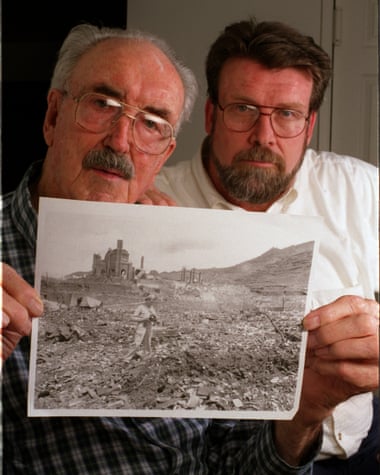The photograph shows devastation in Nagasaki after the atomic bomb: a scorched wilderness where there was once a city. At its centre stands a lone man with a camera.
It was 9 September 1945 and Lt Daniel McGovern, a US Army Air Force cameraman, was documenting ground zero, the point directly below the bomb’s detonation four weeks earlier. Few would recognise McGovern, but the vision of apocalypse is familiar from documentary footage of Hiroshima and Nagasaki at the end of the second world war.
The footage will be shown again this week and next for the 77th anniversaries of the atomic bombings that obliterated the Japanese cities and showed the reality of nuclear war: blasted landscapes, burnt skeletons, radiation sickness.
But those haunting images might not exist were it not for McGovern. As part of the US Strategic Bombing Survey – which studied the impact of bombing – McGovern supervised Japanese and American camera crews in Hiroshima and Nagasaki. Back in the US, he saved the footage from suppression by making secret copies.

Only now, decades later, has his full story emerged. Joe McCabe, a journalist from McGovern’s native County Monaghan in Ireland, has pieced together his remarkable life in a biography, Rebels to Reels, published earlier this month after 20 years of research, including interviews with McGovern before his death in 2005.
McGovern’s relatives travelled to Monaghan last week for the unveiling of a plaque. “I’m overwhelmed. It’s such a surprise to see my uncle Dan and his family recognised,” said Michael McGovern, a nephew.
The research has revealed that McGovern bore witness not only to the dawn of the atomic age but also Ireland’s revolution, Franklin Roosevelt’s White House, wartime Hollywood and the so-called Roswell incident that entered UFO lore.
His presence at key moments in the 20th century has elicited comparisons to Forrest Gump, the fictional character who stumbled through historical events. “Dan was the most interesting person I ever met,” said McCabe.
McGovern was born in Monaghan town in 1905, the son of a policeman. During Ireland’s 1919-21 war of independence, still a boy, he hitched rides with the Black and Tans, a British military force.
The family moved to the US and McGovern, nicknamed Big Mack for his 6ft 5in frame, joined the air force, ending up in its artistic wing, the First Motion Picture Unit. He was a photographer for President Roosevelt before setting up an air force camera training school in Hollywood, where he encountered Ronald Reagan, Clark Gable and other stars.
McGovern flew bombing missions over Germany – surviving two crashes – and filmed footage used in a 1944 documentary, The Memphis Belle: A Story of a Flying Fortress.
His defining work came in Japan a year later, where he took still photographs and filmed with 35mm in black and white and Technicolor.
The fields around Nagasaki were bleached white and the city looked as if a “massive anvil” had flattened it, he later told McCabe. At a ruined school he filmed the bodies of children amid piles of skulls. “Hundreds of kids had been sucked out through the windows. We were always finding bones.”
He filmed harrowing scenes at overwhelmed hospitals, including the agony of a 16-year-old boy named Sumiteru Taniguchi. “His whole back just looked like a bowl of bubbling tomatoes.”
Other patients had rashes, hair loss and bleeding from the nose and mouth – a mysterious malady later identified as radiation sickness.
McGovern also captured the phenomenon of people who had been atomised yet left shadows caused by radiant heat. The two atomic bombs are estimated to have killed more than 200,000 people.
McGovern’s teams amassed 100,000ft of colour footage and enlisted the help of a Japanese newsreel service, Nippon Eigasha, which had 26,000ft of black-and-white footage, much shot before the Americans had arrived. The Irishman helped edit the Japanese footage into a documentary called Effects of the Atomic Bomb on Hiroshima and Nagasaki, and planned to turn the colour footage into another one.
Authorities in Washington, however, classified the material as secret in 1946. “They didn’t want the American public seeing the horrors,” McGovern said. He discreetly made copies at the Pentagon. He stored one set at an air force motion picture depository in Dayton, Ohio, and kept another set himself.
Years passed – McGovern witnessed rocket tests and debunked theories of aliens at Roswell as “a load of crap” – and then in 1967 a US Congressional committee that included Robert Kennedy asked to see the atomic bomb footage. The material had been declassified but no one could find the originals. McGovern, by now a lieutenant colonel, directed the authorities to his copies.
In 1970 the general public got its first glimpse of some of the footage. It had been incorporated into a film called Hiroshima Nagasaki – August 1945 that premiered at New York’s Museum of Modern Art.
The auditorium was packed. At the end, no one made a sound.














